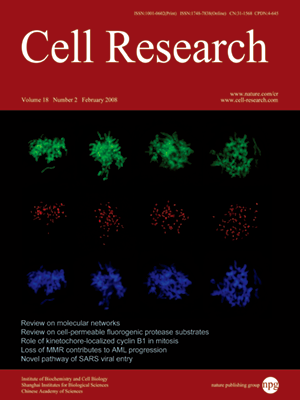
Volume 18, No 2, Feb 2008
ISSN: 1001-0602
EISSN: 1748-7838 2018
impact factor 17.848*
(Clarivate Analytics, 2019)
Volume 18 Issue 2, February 2008: 302-310
ORIGINAL ARTICLES
Involvement of Sp1/Sp3 in the activation of the GATA-1 erythroid promoter in K562 cells
Chun Hui Hou1,*, Jian Huang1,2,*, Qi Ye He1, Cai Ning Zhang1, Xue Jun Zhang1 and Ruo Lan Qian1
1Laboratory of Molecular Cell Biology, Institute of Biochemistry and Cell Biology, Shanghai Institutes for Biological Sciences, Chinese Academy of Sciences, Graduate School of the Chinese Academy of Sciences, 320 Yueyang Road, Shanghai 200031, China
2Department of Biochemistry and Molecular Biology, Shanghai Jiaotong University, School of Medicine, 280 South Chongqing Road, Shanghai 200025, China
Correspondence: Ruolan Qian Xuejun Zhang(rlqian@sibs.ac.cn; xjzhang@sibs.ac.cn)
GATA-1 is a hematopoietic transcription factor that is essential for the terminal maturation of proerythroblasts, megakaryocytic cells and mast cells. The erythroid-specific promoter of the human GATA-1 gene directs the high expression of a reporter gene in K562 cells. Multiple putative transcription factor binding sites were identified in the promoter from the -860 to the -1 base pair (bp). For a better understanding of the transcriptional control of human GATA-1 gene expression, we tested the transcriptional activity of a series of deletions from the 5' end of the 860-bp promoter. A region between -221 and -128 bp retains most of the transcriptional activity of the full-length promoter. Deletion of the CGCCC box at -195 bp reduced reporter gene activity to 60.4%. Further deletion of the CACCC box at -173 bp nearly abolished reporter gene expression, indicating that the CACCC box is more critical. In vitro experiments of electrophoretic mobility shifts and in vivo studies using chromatin immuno-precipitation (ChIP) assays show that the Sp1/Sp3 proteins bind the CACCC site in the nuclei of K562 cells. Coincidently, hyperacetylation of histones in the GATA-1 erythroid promoter was also shown by ChIP assay. Co-transfection of Sp1 expression plasmids and plasmids with a wild-type promoter showed enhanced reporter gene activity in a dose-dependent manner. The combined data demonstrate that Sp1/Sp3, but not EKLF, is involved in the activation of the GATA-1 erythroid promoter, and that histones H3 and H4 are highly acetylated in this promoter region for an actively transcribed GATA-1 gene in K562 cells in which EKLF is barely detectable.
Cell Research (2008) 18:302-310. doi: 10.1038/cr.2008.10; published online 15 January 2008
FULL TEXT | PDF
Browse 2131


